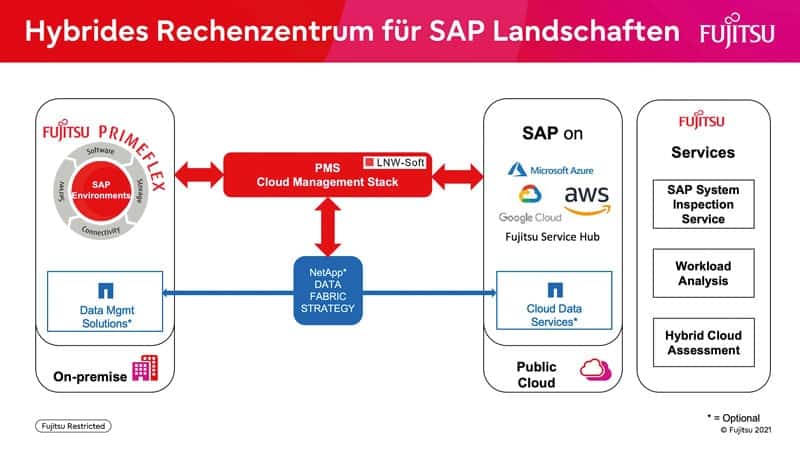Bringing SAP Workloads to a Hybrid Cloud


Moving their SAP environment completely to a public cloud is not yet an option for most German companies. This was the finding of a survey of members of the German-speaking SAP User Group (DSAG) in 2021. Of the companies that have migrated to solutions such as SAP S/4HANA or are planning to do so, 57 percent prefer to implement them in their own data center. One reason is that companies want to continue using their existing IT and storage infrastructure. At the same time, however, SAP users definitely see the advantages of a cloud. These include expanded options for disaster recovery and backup, among other things.
SAP users therefore need an approach that allows them to continue using the existing operating concept of the SAP environment while operating and securing applications, workloads and data in a hybrid cloud environment. In addition, application developers and quality assurance staff should be able to set up development and test environments in a cloud as needed with little effort.
Solution: Hybrid Cloud with NetApp Cloud Volumes Platform
The solution is a hybrid IT environment in conjunction with a customer's spanned data fabric based on NetApp Cloud Volumes ONTAP and Cloud Volumes Services. The solution enables centralized management of workloads, data, and storage resources on premises and on cloud platforms. NetApp Cloud Platform Services supports the leading cloud providers Amazon Web Services (AWS), Google (Google Cloud Platform), and Microsoft (Azure), which are preferred by SAP.

Deployment scenarios: File sharing, backup and test/dev
This opens up a number of use cases in connection with SAP. For example, NetApp's solution can provide a shared file system based on NFS. This gives SAP users access to data storage in the corporate data center and a hybrid cloud. Functions such as snapshots/cloning and deduplication reduce storage requirements.
There are also advantages in backing up SAP systems. With Cloud Volumes ONTAP, companies can create storage snapshots of such data in a cloud. This takes only a few seconds and does not affect the performance of SAP HANA. By backing up data in a hybrid cloud, SAP data can be quickly restored after a ransomware attack, for example.
Quality assurance and development teams also benefit from a hybrid cloud and overarching data and storage management with NetApp Cloud Volumes ONTAP. This is because most SAP landscapes require a large number of system copies that are used for testing and software development. Managing and updating them is time-consuming. With tools such as FlexClone for cloning storage volumes, developers have tools or utilities to deploy SAP system copies in minutes. These clones can also be variably moved back and forth between the enterprise data center and a hybrid cloud. This means easier and more efficient lifecycle management of SAP solutions.
Added value from Fujitsu specialists
However, an SAP environment in conjunction with NetApp Cloud Volumes ONTAP delivers significantly greater benefits when enhanced with solutions from Fujitsu. The company provides SAP users with a coherent package of consulting services, managed services, and hardware and software.
For example, Fujitsu experts can work closely with SAP customers to evaluate whether their SAP infrastructure is optimally aligned to the requirements of the applications, what potential for optimization of the IT landscape is emerging and at what point restrictions due to capacity limits are to be expected in the event of forecast growth. The FUJITSU SystemInspection Service for SAP Solutions is used for this inventory. In a combination of analysis and consulting services, central performance metrics are recorded at the physical and logical level and, based on this, proposals are developed in cooperation with the customer as to how the quality of SAP applications can be increased and optimized through investments in the infrastructure.

Image: Fujitsu/NetApp
Simplify or outsource operations
Another option is to automate the operation of the SAP landscape, for example with the help of PRIMEFLEX for SAP Landscapes solutions from Fujitsu. This combines high-performance and excellent systems from PRIMEFLEX solutions with FlexFrame Orchestrator management software. The combination allows automated operation of your entire SAP system landscape even across classic boundaries, whether on-prem or in the cloud, as one homogeneous landscape.
Companies that want to set up a hybrid SAP environment can also use the "Cloud Management Stack for SAP" software. It can be used to automate and control the processes in an SAP landscape both in the cloud and in the company data center. Alternatively, SAP customers can outsource the operation of their SAP landscape entirely. Fujitsu also provides a platform for this with the Service Hub, via which SAP customers can hand over the operation of their (hybrid) environment to experts from Fujitsu - as a managed service. Fujitsu works in the background with both Amazon AWS and Microsoft Azure and enriches its own offering with services from the hyperscalers.
Flexible financing and utilization models
To make the transition to a hybrid cloud easier for users of Fujitsu solutions, not only from a technological point of view, flexible financing and usage models can also be used. With Fujitsu uSCALE, customers can implement the flexibility of a pay-per-use model, as they are used to in the cloud, in their own data center. The Fujitsu uSCALE pay-per-use consumption service supports business transformation with scalable IT resources that are measurable, cost transparent and aligned with business needs. NetApp has developed a similar approach with Keystone Flex. It consists of variable payment options and storage-as-a-service offerings for hybrid cloud environments.





